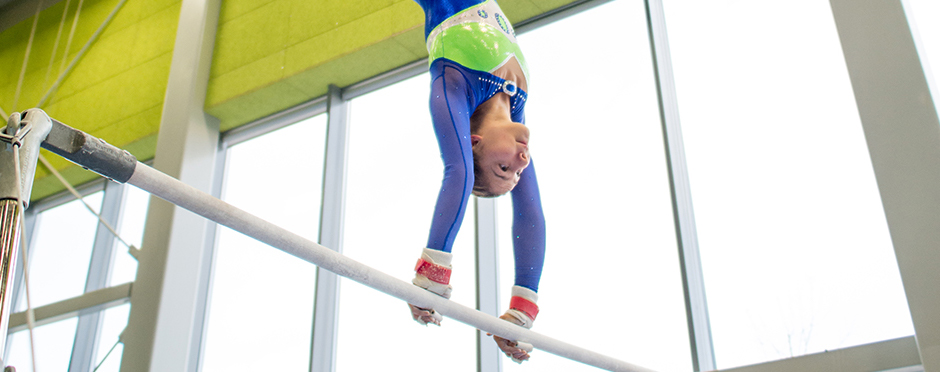
6 Tips for a Healthy High School Gymnastics Season
1 CommentThe gymnastics and cheer seasons’ are underway! Check out our second blog focusing on staying healthy during the gymnastics and cheerleading season. Our second blog by Melissa Winterhalter, PT, DPT, OCS, CSCS, specializes in gymnastics and performing arts. She is a Board Certified Orthopedic Specialist and a NSCA Certified Strength & Conditioning Specialist.
6 Tips For A Healthy High School Gymnastics Season
-
If You Are Taping Or Bracing, You Should Also Be Strengthening
Many gymnasts tape their ankles or brace their knees to protect them during the season. Typically, this is due to a previous injury. While taping and bracing can be helpful in preventing future injury, it is very important to strengthen the muscles around the injured area to give the gymnast more stability during take off and landing. This is also true for Tiger Paws! Many gymnasts wear wrist supports such as Tiger Paws to decrease wrist pain, especially for tumbling and vault. Ask your athletic trainer or physical therapist for some strengthening and stretching exercises to practice for any body part that is taped or braced!
-
Think Quality, Not Quantity
High school gymnastics season consists of frequent competition, much more often than club gymnastics. Athletes often have at least two meets per week. This means that gymnasts are doing full routines more often, and landing on firm competition mats instead of softer landings. Make sure that you are making your repetitions count at practice! It is much more effective (and efficient) to perform a skill really well 4-5 times instead of practicing it over and over 10-15 times and making mistakes. This can also decrease overuse injuries. Talk to your coach about the ideal number of repetitions for each skill and each routine at practice.
-
Be Nice To Your Feet
While gym shoes might not be the cutest shoe option in your closet, they typically provide more support than boots. Many boots have very little arch support, causing the boot itself to roll inward, which places your ankle in a pronated position. When you walk around in that alignment, it puts more strain on your foot and ankle which can also lead to more stress on the knees, hips and even the lower back.
-
Fuel Your Body
When you have practice right after school, make sure that you are eating a healthy snack before practice. Typically lunch was several hours ago and you will need to refuel to give yourself some energy. Trail mix, peanut butter and fruit are good snack options to bring from home. If you have to snack from the vending machine, choose healthier options such as pretzels or crackers instead of chips or candy bars. It is also very important to stay hydrated! Bring a water bottle with you to drink during the day, after school and throughout practice.
-
Keep Yourself Warm During The Meet
During down time at meets, make sure that you are keeping your body warm before the next event. Put your clothes and even your shoes back on to support your feet. Keep your body moving by jogging and doing some kicks and jumps to provide an “active” stretch to your muscles.
-
Don’t Ignore The Pain
If you are hurting, say something. Gymnasts are often afraid to tell a coach or athletic trainer that something hurts because they don’t want to stop competing. However, catching a minor injury early can prevent a more serious injury later. Talk to your athletic trainer or a gymnastics specific physical therapist to see if there are exercises or skill modifications to help with your injury during and after the season.
If at any point you feel a new pain or think it would be best to have a professional take a look, schedule your free assessment today to keep you tucking, twisting and turning! Read part 1 here.
The Athletico blog is an educational resource written by Athletico employees. Athletico bloggers are licensed professionals who abide by the code of ethics outlined by their respective professional associations. The content published in blog posts represents the opinion of the individual author based on their expertise and experience. The content provided in this blog is for informational purposes only, does not constitute medical advice and should not be relied on for making personal health decisions.
Melissa Winterhalter, PT, DPT, OCS, CSCS
Athletico – Des Plaines
Melissa is a former level 10 and high school gymnast. She competed for Stevenson High School and was part of 3 consecutive state championship winning teams. She went on to compete for the University of Illinois at Urbana-Champaign and earned her Bachelor of Science degree in Kinesiology. She earned her Doctor of Physical Therapy degree from Northwestern University and recently completed a residency program to become an orthopedic clinical specialist. Melissa’s passion is treating gymnasts with a specific plan of care tailored to the individual athlete’s skill level, age and goals. She is currently the team physical therapist for American Academy of Gymnastics in Wheeling and works at the Athletico – Des Plaines facility.


1 Comment
Deanna R. Jones
I really appreciate these tips to help my high school gymnastics team improve when they compete this year. It seems like my team can really benefit from your point about keeping your body warm during the meet. My team often has issues with flexibility during meets because they don’t move around very much and stretch. I agree, stretching and moving around a lot will help a great deal to keep their muscles warm and flexible. By the way, I really liked the video clip that you posted. That was the most incredible save that I’ve ever seen when that girl was about to fall off the beam. Transferring her weight into a handstand like that made it look like that fall was almost on purpose.